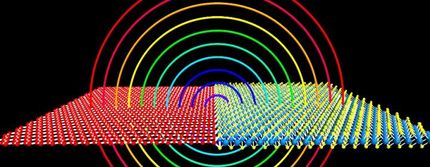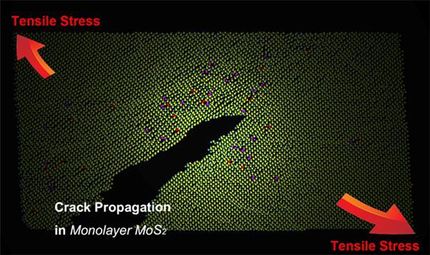Spin dynamics in an atomically thin semi-conductor
Researchers at the National University of Singapore (NUS) and Yale-NUS College have established the mechanisms for spin motion in molybdenum disulfide, an emerging two-dimensional (2D) material. Their discovery resolves a research question on the properties of electron spin in single layers of 2D materials, and paves the way for the next generation of spintronics and low-power devices.

The sketch shows scattering in the two valleys of MoS2 close to the conduction band by spin-orbit and intervalley scattering. While the first flips the spin orientation, the second changes valley with preserved spin. Very different scattering times result in the observed transition of weak antilocalisation to weak localization as experimentally observed in the magnetoresistance as function of temperature and magnetic field (right).
Hennrik Schmidt
Molybdenum disulfide (MoS2), a class of transition metal dichalcogenide compounds, has attracted great attention due to wide recognition of its potential for manipulating novel quantum degrees of freedom such as spin and valley. Due to its unique material properties, a single layer of MoS2 has the potential to be used for spin transistors, where both electric current and spin current can be switched on and off independently. Despite this potential for application, there have not been any experimental studies on the mechanism for spin dynamics in MoS2.
To address this gap, scientists from the Centre for Advanced 2D Materials at NUS used highly precise measurements of the classical and quantum motion of electrons to extract information on how long spins live in this new material.
The team of scientists led by Assistant Professor Goki Eda, co-leader of this study who is from the NUS Department of Physics and Department of Chemistry, thinned down a crystal of molybdenite, a mineral of MoS2, to less than one nanometer. Here, the electrons live in a purely 2D plane that is just one atom thick. The researchers then successfully injected a high density of electrons in this ultra-thin material to enable measurements in the quantum mechanical regime. Quantum transport measurements at low temperatures of 2 Kelvin ( 271 degrees Celsius) revealed a surprising transition, where quantum mechanical wave interference switched from constructive to destructive with increasing magnetic field.
Mr Indra Yudhistira, a Research Associate with the NUS Department of Physics who is under the supervision of Assistant Professor Shaffique Adam, co-leader of the NUS study who is from Yale-NUS College and NUS Department of Physics, demonstrated that this crossover was caused by spin dynamics.
By comparing the theoretical and experimental results, the two research groups were able to extract spin lifetimes and also determine that the relaxation was driven by the Dyakonov-Perel type where electron spins live longer in dirtier samples.
"Aside from investigating the fundamental properties of low field magnetotransport in molybdenum disulfide, our team was able to establish the mechanism for spin scattering to reveal the properties of the electron spin," said Dr Hennrik Schmidt, who was a Research Fellow working under the supervision of Asst Prof Eda when the study was conducted.
Commenting on the significance of the discovery, Asst Prof Adam noted that spin-based devices would generally lead to lower energy consumption as compared to conventional electronics. He explained, "The combination of MoS2 being a semiconductor and the long spin lifetimes open up opportunities in spintronics, where the electron spin and not the electron charge is used to transport information. Such unconventional devices could allow for next generation low-power devices."
Professor Yoshihiro Iwasa, Director of the Center for Quantum-Phase Electronics at the University of Tokyo, and a world expert on quantum devices who first reported superconductivity in this class of materials remarked, "2D materials have been anticipated as a promising platform for spintronics. I feel that this very comprehensive study of the analysis of the electron spin life time will provide crucial information for further pushing the research toward the realisation of a new generation of spintronic devices."
Original publication
Other news from the department science

Get the chemical industry in your inbox
By submitting this form you agree that LUMITOS AG will send you the newsletter(s) selected above by email. Your data will not be passed on to third parties. Your data will be stored and processed in accordance with our data protection regulations. LUMITOS may contact you by email for the purpose of advertising or market and opinion surveys. You can revoke your consent at any time without giving reasons to LUMITOS AG, Ernst-Augustin-Str. 2, 12489 Berlin, Germany or by e-mail at revoke@lumitos.com with effect for the future. In addition, each email contains a link to unsubscribe from the corresponding newsletter.





























































